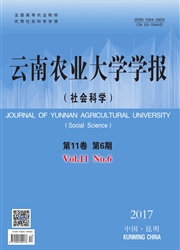

 中文摘要:
中文摘要:
近几年来,花椒根腐病是危害云南花椒主产区的三大病害之一,并且造成了巨大的经济损失。为此,以花椒根腐病为防治对象,选用根腐净、50%福美双、58%甲霜灵锰锌、45%五氯·福4种药剂作了室内药剂筛选和田间防治试验。室内生测结果表明:4种药剂对茄腐皮镰孢菌(Fusarium solani)菌丝生长的平均抑菌率分别为83.66%,96.10%,94.04%,87.40%,EC50为1.0437,0.2307,0.5130,0.5901mg,/mL,均具有较强的抑制作用;大田小区试验结果表明:无论是花椒根腐病菌接种前用药还是接种后用药,4种药剂对花椒根腐病的扩展蔓延均具有一定防效,在病原菌接种前用药,平均防效分别达到了83.64%,84.80%,75.27%,64.99%;接种后用药的平均防效分别为70.68%,72.68%,57.82%,52.89%,与室内毒力测定结果一致,且病原菌接种前用药具有很好的预防作用。
 英文摘要:
英文摘要:
The Chinese Prickly Ash root rot [ Fusarium solani ( Mart. ) Sacc. ] is one of three major diseases in the main producing regions in Yongshan county of Yunnan Province. In recent years, it caused enormous economic losses for the local farmer. In two experiments, indoor medicament toxicity measurement and control testing with the field of the Chinese Prickly Ash root rot, we selected that Gen-FuJing, 50% Thiram, 58% Ridomil MZ and 45% Quintozene-thiram. The results of medicament toxicity measurement indicated that the average inhibition rate of the growth mycelium of four medicaments on Fusarium solani in the PDA dish were 83.66%, 96. 10%, 94. 04%, and 87.40%, respectively, EC50 is 1. 043 7,0. 230 7, 0. 513 0, 0. 590 1 mg/mL, respectively. The results of the control tested with the field indicated that four medicaments had obviously control effect at different levels before or after inoculating F. solani to the root of Chinese Prickly Ash. The control efficiency of four medicaments applied on healthy Chinese Prickly Ash before inoculating F. solani in latter experiment were 83.64%, 84.80%, 75.27%, and 64. 99%, respectively. And the control efficiency of four medicaments applied on unhealthy Chinese Prickly Ash after inoculating F. solani in latter experiment were 70. 68%, 72. 680%, 57.82%, and 52. 89%, respectively
 同期刊论文项目
同期刊论文项目
 同项目期刊论文
同项目期刊论文
 The genus Mimumesa from China with description of two new species (Hymenoptera: Apoidea: Crabronidae
The genus Mimumesa from China with description of two new species (Hymenoptera: Apoidea: Crabronidae 期刊信息
期刊信息
